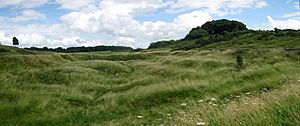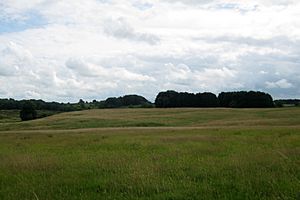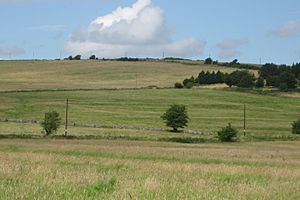Charterhouse (Roman town) facts for kids
Charterhouse was a small but important town in the Roman province of Britannia, which is now England. Its ancient site is found near the village of Charterhouse-on-Mendip in the English county of Somerset.
Historians are not completely sure about its original Latin name. Some think it might have been Iscalis. Other clues, like inscriptions on Roman lead blocks, suggest it could have been called Vebriacum. This area was also home to an Iron Age hill fort called Charterhouse Camp. Today, the entire Roman site is protected as a Scheduled Ancient Monument, meaning it's a very important historical place.
Roman Mining Town
Charterhouse grew into a busy settlement because of the ancient lead and silver mines nearby. These mines had been used even before the Romans arrived. The Romans took over and greatly expanded the mining operations. The lead found here in the Mendip Hills contained a small amount of silver, about 0.4%. This silver was very valuable to the Romans, who used it to help pay their powerful army.
Mining probably started around AD 49. At first, the Roman army, specifically the Second Legion, controlled the mines very strictly. They even had a small fort or fortified area next to the mines. This fort was likely used to guard the valuable lead blocks, often called 'pigs' of lead. Later, civilian companies took over the mining work, probably because the silver content wasn't high enough for the army to manage directly. The raw metal was melted down right there at the site. Then, the finished lead was sent out on a small road that connected to a major Roman road called the Fosse Way. It was also likely shipped from a small port nearby at Cheddar.
Ancient Amphitheatre
Just west of the Roman settlement, there was an amphitheatre. This is quite special because it's the only Roman amphitheatre in England found right next to a lead mine. This shows how important the Mendip lead mines were to the Romans. The amphitheatre was about 32 meters (105 feet) long and 24.4 meters (80 feet) wide. The banks where people sat to watch the shows are still visible today, rising about 4.5 meters (15 feet) above the central arena.
Experts studied the amphitheatre in 1909. It was probably a place where Roman soldiers stationed at the fort could enjoy entertainment, like gladiator fights or animal shows.
See also
- Roman engineering
- Roman mining
- Roman technology




